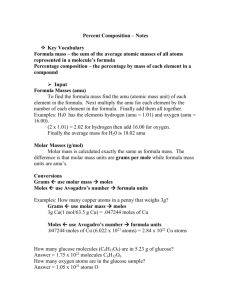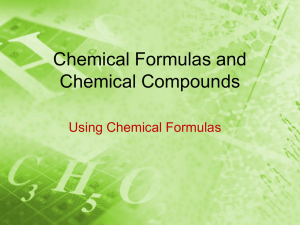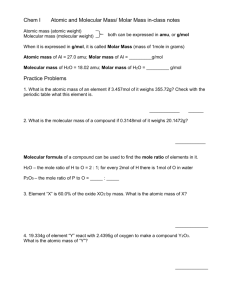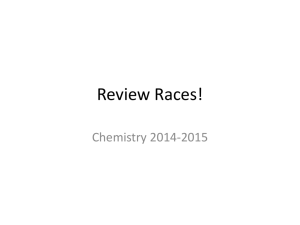Using Chemical Formulas Power ponit
advertisement
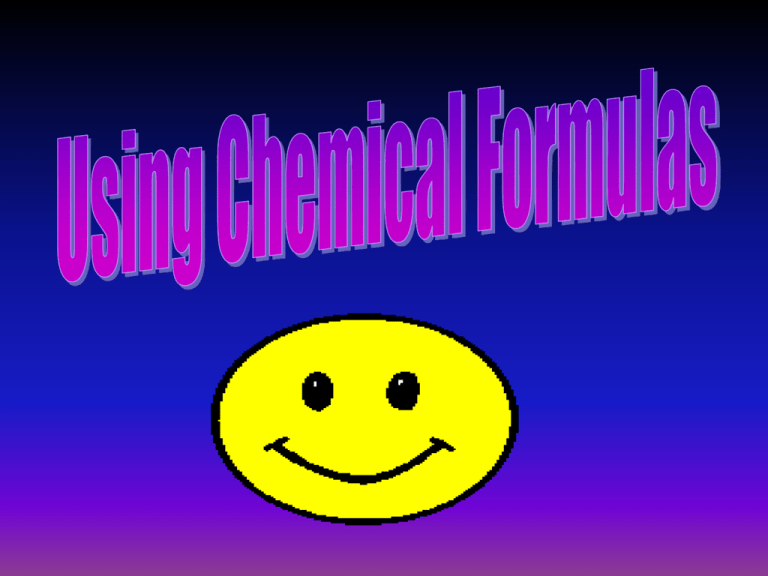
•The chemical formula for water is H2O. •How many atoms of hydrogen and oxygen are there in one water molecule? H2O 2 hydrogen atoms 1 oxygen atom •How might you calculate the mass of a water molecule, given the atomic masses of hydrogen and oxygen? •In this section, you will learn how to carry out these and other calculations for any compound. Using Chemical Formulas •As well as indicating the elements and the relative numbers of atoms or ions of each element in a compound, chemical formulas can also be used to calculate formula mass, molar mass, and the percent composition of a compound. Formula Mass •The formula mass of any molecule, formula unit, or ion is the sum of the average atomic masses of all the atoms represented in its formula. •The units for formula mass are atomic mass units (amu). •The mass of a water molecule, H2O, can be referred to as a molecular mass. •The mass of one formula unit of an ionic compound, such as NaCl, is not a molecular mass. Example: Find the formula mass for H2O. H2O has 2 hydrogen atoms and 1 oxygen atom. Atomic mass of hydrogen = 1.01 amu Atomic mass of oxygen = 16.00 amu 2 hydrogen atoms x 1.01 amu = 2.02 amu 1 oxygen atom x 16.00 amu = 16.00 amu Total Formula mass of H2O 18.02 amu Molar Masses •The molar mass of a substance is equal to the mass in grams of one mole, or 6.02 x 1023 particles, of the substance. •Units for molar mass are g/mol. •The molar mass of a compound is calculated by summing the masses of the elements present in a mole of the molecules or formula units that make up that compound. •A compound’s molar mass is numerically equal to its formula mass. Example: Find the molar mass for KClO3. KClO3 has 1 potassium (K) atom, 1 chlorine atom (Cl), and 3 oxygen (O) atoms. Atomic mass of potassium = 39.10 amu Atomic mass of chlorine = 35.45 amu Atomic mass of oxygen = 16.00 amu 1 potassium atom x 39.10 amu = 39.10 amu 35.45 amu 1 chlorine atom x 35.45 amu = 48.00 amu 3 oxygen atoms x 16.00 amu = Total 122.55 amu Since a compound’s molar mass is numerically equal to its formula mass (KClO3 = 122.55 amu) the molar mass of KClO3 would be Numerically equivalent to formula mass but units are different. This tells us that if we have one mole of KClO3 we would have 122.55 g of KClO3 or 6.02 x 1023 formula units of KClO3. Molar Mass as a Conversion Factor •The molar mass of a compound can be used as a conversion factor to relate an amount in moles to a mass in grams for a given substance. •To convert moles to grams, multiply the amount in moles by the molar mass. •Amount in moles x molar mass (g/mol) = mass in grams Example: What is the mass in grams of 2.50 mol of oxygen (O2) gas? Given: 2.50 mol O2 Unknown: mass of O2 in grams Solution: mol O2 → grams O2 mol O2 x molar mass (g / mol ) g O2 Determine the molar mass of O2. O2 has 2 oxygen atoms. Atomic mass of O is 16.00 amu. 2 oxygen atoms x 16.00 = 32.00 amu Remember that molar mass is numerically equal to the formula mass so the molar mass of O2 = 32.00 g/mol. 2.50 mol O x 32.00 g O2 = 80.0 g O2 2 1 mol O2 Ibuprofen, C13H18O2, is the active ingredient in many nonprescription pain relievers. Its molar mass is 206.31 g/mol. a. If the tablets in a bottle contain a total of 33 g of ibuprofen, how many moles of ibuprofen are in the bottle? 33 g C13H18O2 x 1 mol C13H18O2 = 0.16 mol C13H18O2 206.31 g C13H18O2 b. How many molecules of ibuprofen are in the bottle? Remember we have 0.16 mol. 0.16 mol C13H18O2 x 6.02 x 1023 molecules 1 mol = 9.6 x 1022 molecules C13H18O2 c. What is the total mass in grams of carbon in 33 g of ibuprofen? To start, determine the number of moles of carbon per 1 mole of C13H18O2. There are 13 moles of carbon per 1 mole of C13H18O2. Two conversion factors are needed to solve problem: number of moles of carbon per mole of C13H18O2 and the molar mass of carbon. 13 moles C 12.01 g C 1 mol C13H18O2 1 mol C 13 mol C 0.16 mol C13H18O2 x 1 mol C13H18O2 12.01 g C x 1 mol C = 25 g C Problem: Consider a sample of 10.0 g of the gaseous hydrocarbon C3H4 to answer the following questions. a. How many moles are present in the sample? b. How many molecules are present in the C3H4 sample? c. What is the total mass in grams of carbon in the sample? Additional Problems: 1. How many molecules of aspirin, C9H8O4, are there in 0.165 moles of aspirin? 2. If we have 6.54 x 108 molecules HCN, how many moles of HCN are there? 3. What is the total mass of nitrogen in 1.25 moles of Zn(NO3)2? Percent Composition •It is often useful to know the percentage by mass of a particular element in a compound. •For example, suppose the compound potassium chlorate, KClO3, were to be used as a source of oxygen. It would be useful to know the percentage of oxygen in the compound. •To find the mass percentage of an element in a compound, the following equation can be used. mass of element in sample of compound x 100 mass of sample of compound •The mass percentage of an element in a compound is the same regardless of the sample’s size. •The percentage of an element in a compound can be calculated by determining how many grams of the element are present in one mole of the compound. •The percentage by mass of each element in a compound is known as the percentage composition of the compound. mass of element in 1mol of compound x 100 % element in compound molar mass of compound Percentage Composition of Iron Oxides Example: Find the percentage composition of copper(I) sulfide, Cu2S. 1) Find the molar mass of the compound. Cu2S has 2 copper atoms and 1 sulfur atom. The atomic mass of copper is 63.55 amu and the atomic mass of sulfur is 32.07 amu. 2 copper atoms x 63.55 amu = 127.1 amu 32.07 amu 1 sulfur atom x 32.07 amu = The formula mass of Cu2S = 159.2 amu. The molar mass of Cu2S = 159.2 g/mol. 2) Use the mass of each element present in one mole of the compound to calculate the mass percentage of each element. 2 atoms of Cu = 127.1 g Molar mass of Cu S 2 1 atom of S = 32.07 g = 159.2 g. mass of element of 1mol of compound x 100 molar mass of compound 127.1g Cu x 100 79.85% Cu 159.2 g Cu 2S 32.07 g S x 100 20.15% S 159.2 g Cu 2S A good check is to see if the results add up to about 100%. (Because of rounding, the total may not always be exactly 100%).
